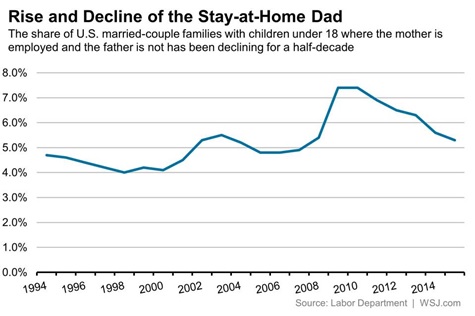By Ben Leubsdorf
Wall Street Journal
Apr 22, 2016 1:27 pm ET
The number of stay-at-home dads surged during the recession, but a stronger job market is drawing many of them back into the workplace.
In 2015, 5.3% of U.S. families with children under 18 and married parents featured an employed mother and a father who was either unemployed or not in the labor force, the Labor Department said Friday. That was down from 5.6% in 2014, the fifth consecutive year of decline and erasing most of the rise seen during the 2007-09 recession.
“Certainly it seems there was a huge economic factor playing a role there,” said Gretchen Livingston, a senior researcher at Pew Research Center.
Still, the practice of fathers staying home has risen in recent decades, reflecting a shift in social roles as well as economic forces.
The share of married-couple families with a working mom and a nonworking dad rose during the 2007-09 recession from 4.8% in 2005 and 2006 to 7.4% in 2009 and 2010, according to Labor Department data. As of last year, it was equal to its long-run average of 5.3% since 1994.
It remains elevated from the levels seen just before the downturn, though, mirroring a similar trend following the 2001 recession. Ms. Livingston said it will be interesting to see if it continues to decline, or if it again levels off somewhat above its prerecession rate.
“Over time, there’s clearly been an increase in the number of stay-at-home dads, regardless of where we are in the economic cycle,” she said.
The share of families with stay-at-home moms, after a long decline, also has been rising since the 1990s. Last year, fathers worked outside the home and mothers did not in 30.8% of married-couple families with children, unchanged from 2014 and up from 28.5% in 1995, according to the Labor Department.
Both parents were employed in 60.6% of married-couple families with kids in 2015, up from 60.2% the prior year but still well below 2008’s level of 62.1%. That included working parents in both full- and part-time jobs.
An improving U.S. job market—the unemployment rate in March was 5%, workforce participation has risen over the past six months and job creation remains solid—has brightened the economic picture for many households. Some 6.9% of all families in 2015 included an unemployed person, down from 8% in 2014.
That figure, however, conceals a vast racial divide. Some 12% of African-American families last year had an unemployed member, twice the 6% rate for white families. Some 9.7% of Hispanic families had an unemployed member, as did 5.7% of Asian families.
